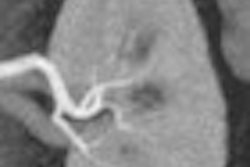Sunday, November 27 | 11:05 a.m.-11:15 a.m. | SSA08-03 | Room E450B
A study from Massachusetts General Hospital has shown that automated kV selection is feasible, providing the benefits of lower kV imaging without complicated protocols."There are known benefits of low kV scanning such as improvement in the iodine attenuation (desirable in vascular studies and for detecting hypervascular lesions/tumors) and reduction in the patient's radiation dose," Dr. Daniella Pinho wrote in an e-mail to AuntMinnie.com. "However, despite the known benefits, lower kV selection has not been popular for routine non-CT-angiography abdomen exams due to the concerns of excessive image noise, and lack of defined parameters for an appropriate kV selection in an individual patient and the exam."
Routine contrast-enhanced CT of the abdomen was performed using auto kV optimization mode (CARE kV, Somatom Definition Flash, Siemens Healthcare) in 30 patients, according to the researchers. In another 18 patients, scanning conformed to weight-based kV selection protocols, and the two sets of exams were compared.
The radiation dose in the group that used CARE kV and iterative reconstruction was significantly lower than in the group with weight-based kV, and it was also lower than with fixed 120 kV using filtered back projection reconstruction.
In 78% of patients, the scanner prescribed 100 kV instead of 120 kV based on the protocol, and 120 kV was selected in the remaining 12%. Image quality was good to excellent, and the mean radiation dose dropped from 9.03 mSv to a mean 6.35 mSv.
"Automatic selection of kV is feasible without any workflow impediments," Pinho concluded. "We have further optimized our parameters on this scanner, and automated kV selection is a default for almost all of our abdomen exams."



















